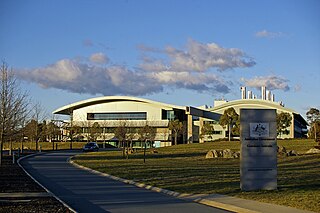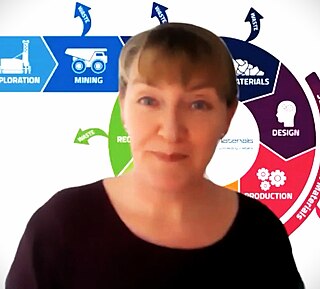
The Department for Education and Skills (DfES) was a United Kingdom government department between 2001 and 2007, responsible for the education system as well as children's services in England.

A geologic map or geological map is a special-purpose map made to show various geological features. Rock units or geologic strata are shown by color or symbols. Bedding planes and structural features such as faults, folds, are shown with strike and dip or trend and plunge symbols which give three-dimensional orientations features.

Sir Richard John Griffith Bt. FRS FRSE FGS LLD, was an Irish geologist, mining engineer and chairman of the Board of Works of Ireland, who completed the first complete geological map of Ireland and was the author of the valuation of Ireland; subsequently known as Griffith's Valuation.

John MacCulloch FRS was a Scottish geologist. He was the first geologist to be employed by the government in Britain and is best known for his pioneering texts on geology and for producing the first geological maps of Scotland. He introduced the word "malaria" into the English language.

Geoscience Australia is an agency of the Australian Government. It carries out geoscientific research. The agency is the government's technical adviser on all aspects of geoscience, and custodian of the geographic and geological data and knowledge of the nation.

Black Combe is a fell in the south-west corner of the Lake District National Park, England, just 4 miles (6.4 km) from the Irish Sea. It lies near the west coast of Cumbria in the borough of Copeland and more specifically, in the ancient district of Millom. It is 1,970 ft (600 m) high and stands in isolation, some 10 mi (16 km) away from any higher ground; this factor offers an excellent all-round panoramic view of land and sea, weather permitting.

The Geological Museum, started in 1835 as one of the oldest single science museums in the world and now part of the Natural History Museum in London. It transferred from Jermyn Street to Exhibition Road, South Kensington in 1935 in a building designed by Sir Richard Allison and John Hatton Markham of the Office of Works.

Research Councils UK, sometimes known as RCUK, was a non-departmental public body that coordinated science policy in the United Kingdom from 2002 to 2018. It was an umbrella organisation that coordinated the seven separate research councils that were responsible for funding and coordinating academic research for the arts, humanities, science and engineering. In 2018 Research Councils transitioned into UK Research and Innovation (UKRI).
Innovate UK is the United Kingdom's innovation agency, which provides money and support to organisations to make new products and services. It is a non-departmental public body operating at arm's length from the Government as part of the United Kingdom Research and Innovation organisation.

Vanessa Vivienne Lawrence is a British businessperson, geographer and speaker working internationally.

The Ordnance Survey (OS) is the national mapping agency for Great Britain. The agency's name indicates its original military purpose, which was to map Scotland in the wake of the Jacobite rising of 1745. There was also a more general and nationwide need in light of the potential threat of invasion during the Napoleonic Wars. Since 1 April 2015, the Ordnance Survey has operated as Ordnance Survey Ltd, a government-owned company, 100% in public ownership. The Ordnance Survey Board remains accountable to the Secretary of State for Science, Innovation and Technology. It was also a member of the Public Data Group.

Digimap is a web mapping and online data delivery service developed by the EDINA national data centre for UK academia. It offers a range of on-line mapping and data download facilities which provide maps and spatial data from Ordnance Survey, British Geological Survey, Landmark Information Group and OceanWise Ltd Ltd.,, Getmapping Ltd, the Environment Agency, OpenStreetMap, CollinsBartholomew Ltd, and various other sources.
The Afon Marlais is a right-bank tributary of the River Tâf in Pembrokeshire, West Wales. It flows through the Vale of Lampeter to join the Tâf just west of Whitland. Its length is approximately 10 kilometres (6.2 mi). The name derives from the Welsh 'marw glais' and signifies a 'stagnant stream'.

The Networking and Information Technology Research and Development (NITRD) program consists of a group of U.S. federal agencies to research and develop information technology (IT) capabilities to empower Federal missions; support U.S. science, engineering, and technology leadership; and bolster U.S. economic competitiveness.

BRGM is France's public reference institution in Earth Science applications for the management of surface and subsurface resources and risks. It is the French Geological Survey.

The Department for Business, Energy, and Industrial Strategy (BEIS) was a department of His Majesty's Government.

Jane Anne Plant CBE, FREng, FRSE, FRSA (1945–2016) was a leading geochemist, scientist, and author. Plant was a pioneer in the field of geochemical surveys and environmental surveys. She was Chief Scientist at the British Geological Survey and was a Professor of Geochemistry at Imperial College London. Plant was also highly involved in the Institution of Mining & Metallurgy where she was involved in many aspects including a role on the Council, and was the first female President of the Institution of Mining & Metallurgy, a post she held from 2001 to 2002. This gave her an extensive network of key connections with government, industry and academia.

Karen Hanghøj is a Danish geologist with expertise in the sustainable management of natural mineral resources. In 2019 she was appointed director of the British Geological Survey. She was the first woman to take on this role since the survey was founded in 1835.

















